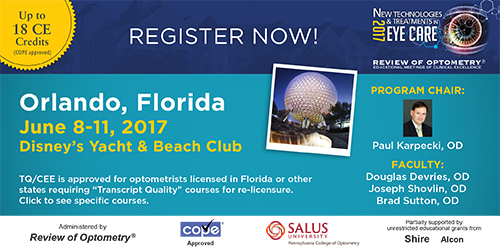
A
weekly e-journal by Art Epstein, OD, FAAO
Off the Cuff: Embrace Technology or Die
Last week, I sounded a warning about how emerging and potentially dangerous technology is being forced down an unsuspecting public’s throat. 1-800 Contacts and Opternative, funded by venture capitalists, are waging a war on optometry using an army of PR flacks and strategists. With an additional eight million in funding, expect Simple Contacts to join the fray.
|
|||||
|
|||
| Water Exposure is a Common Risk Behavior Among Contact Lens Wearers | ||||
This study was conducted to understand soft contact lens (SCL) and gas-permeable (GP) lens wearers' behaviors and knowledge regarding exposure of lenses to water. The Contact Lens Risk Survey (CLRS) and health behavior questions were completed online by a convenience sample of 1,056 SCL and 85 GP lens wearers ages 20 to 76 years. Participants were asked about exposing their lenses to water and their understanding of risks associated with these behaviors. Chi-square analyses examined relationships between patient behaviors and perceptions. GP lens wearers were more likely than SCL wearers to rinse or store lenses in water (rinsing: 91% GP, 31% SCL; storing: 33% GP, 15% SCL). Among SCL wearers, men were more likely to store (24% vs. 13%) or rinse (41% vs. 29%) their lenses in water. Showering while wearing lenses was more common in SCL wearers (86%) than GP lens wearers (67%). Swimming while wearing lenses was reported by 62% of SCL wearers and 48% of GP lens wearers. Wearers who rinsed or stored lenses in water reported that this behavior had little or no effect on their infection risk compared with those who did not. Both SCL and GP lens wearers perceived that distilled water was safer than tap water for storing or rinsing lenses. Despite previously published evidence of Acanthamoeba keratitis's association with water exposure, most SCL, and nearly all GP, lens wearers regularly exposed their lenses to water, with many unaware of the risk. |
||||
SOURCE: Zimmerman AB, Richdale K, Mitchell GL, et al. water exposure is a common risk behavior among soft and gas-permeable contact lens wearers. Cornea. 2017; Apr 13. [Epub ahead of print]. |
||||
|
|||||||
| Prevalence of Depression & Depressive Symptoms Among Eye Disease Patients | ||||
The prevalence of depression among different eye disease patients varies across studies and has not been systematically reviewed. This study is to provide a summary of the prevalence of depression among eye disease patients. PubMed, Medline, Embase and Cochrane Library were searched from January 1990 to December 2015 to identify studies with information on the prevalence of depression among ophthalmic patients. A random/fixed-effects meta-analysis was used to estimate the pooled prevalence of depression among eye disease patients. Heterogeneity was assessed with the I2 test. Twenty-eight studies were selected from 3,162 references. The overall pooled prevalence of depression or depressive symptoms with eye disease was 25% (1,502/6,589 individuals) ranging from 5.4% to 57.0%. Regarding different disease categories, the highest prevalence was revealed for dry eye disease (DED) with 29%, followed by 25% for glaucoma patients, 24% for age-related macular degeneration (AMD) patients and 23% for cataract patients. The increased pooled prevalence of depression was identified in those with eye diseases compared with healthy controls. Substantial heterogeneity was identified across most estimates. Researchers suggested that further research was needed to identify effective strategies for preventing and treating depression among eye disease patients. |
||||
SOURCE: Zheng Y, Wu X, Lin X, et al. The prevalence of depression and depressive symptoms among eye disease patients: A systematic review and meta-analysis. Sci Rep. 2017;7:46453. |
||||
 |
||
| Risk Factors For Bleb-related Infection Following Trabeculectomy Surgery | ||||
Bleb-related infection (BRI) is a devastating complication of trabeculectomy surgery. The aim of this study was to identify ocular risk factors for BRI with specific emphasis on ocular surface parameters. It has been suggested that BRI frequency has increased since the introduction of antimetabolites, particularly mitomycin C. As such, researchers conducted a clinical study of BRI following trabeculectomy surgery to investigate risk factors by documenting historical data review from patients records, self-reported questionnaires specific to ocular surface symptoms, and a repeat detailed clinical examination of the lid, ocular surface and tear film. Twenty-eight cases and 31 controls were assessed. The overwhelming risk factor for development of BRI was chronic blepharitis. No increased risk was identified with the antimetabolite used during trabeculectomy surgery or the type of conjunctival reflection adopted for surgery. Neither age nor dry eyes were identified as risk factors. An increased risk of BRI was identified in eyes with chronic blepharitis. To minimize the risk of infection following trabeculectomy surgery, researchers wrote that it may be advisable to manage lid disease in these patients prior to performing trabeculectomy surgery or offer an alternative treatment such as a shunt. |
||||
SOURCE: Rai PA, Barton K, Murdoch IE. Risk factors for bleb-related infection following trabeculectomy surgery: Ocular surface findings-a case-control study. Br J Ophthalmol. 2016; Oct 18. [Epub ahead of print]. |
||||
|
|||
 |
||
| News & Notes | |||||||||
| B+L Program: 180,000-Plus Units of CLs & Blister Packs Recycled Bausch + Lomb announced that more than 180,000 units of used contact lenses and blister packs have been recycled through the Bausch + Lomb One by One Recycling Program. To date, more than 1,800 optometry offices have signed up to participate in the free program, developed by Bausch + Lomb in collaboration with TerraCycle, a recycling company. On Earth Day on April 18, Bausch + Lomb educated consumers about the program during a celebration hosted by Earth Day Initiative. For each pound of waste recycled through the program, Bausch + Lomb makes a $1 donation to Optometry Giving Sight. Read more. |
|||||||||
| LA County DHS Study Demonstrates Increase in DR Screenings A study by the Los Angeles County Department of Health Services, published in the March 2017 issue of JAMA Internal Medicine, revealed that a telemedicine-based diabetic retinopathy screening program utilizing the eConsult system, developed by Safety Net Connect, was a promising and sustainable intervention for improving access to diabetic eye care for underinsured and uninsured individuals. Among a subset of 21,222 individuals who participated in the program between September 2013 and December 2015, pre-program and post-program data comparisons revealed a significant increase in specialty eye care access. Wait times for screening decreased by 89.2 percent (from 158 to 17 days), and overall annual DR screening rates increased by 16 percent (from 40.6 percent to 56.9 percent). Read more. |
|||||||||
FDA Approves Genentech’s Lucentis (Ranibizumab Injection) for DR
|
|||||||||
|
Optometric Physician™ (OP) newsletter is owned and published by Dr. Arthur Epstein. It is distributed by the Review Group, a Division of Jobson Medical Information LLC (JMI), 11 Campus Boulevard, Newtown Square, PA 19073. HOW TO ADVERTISE |





